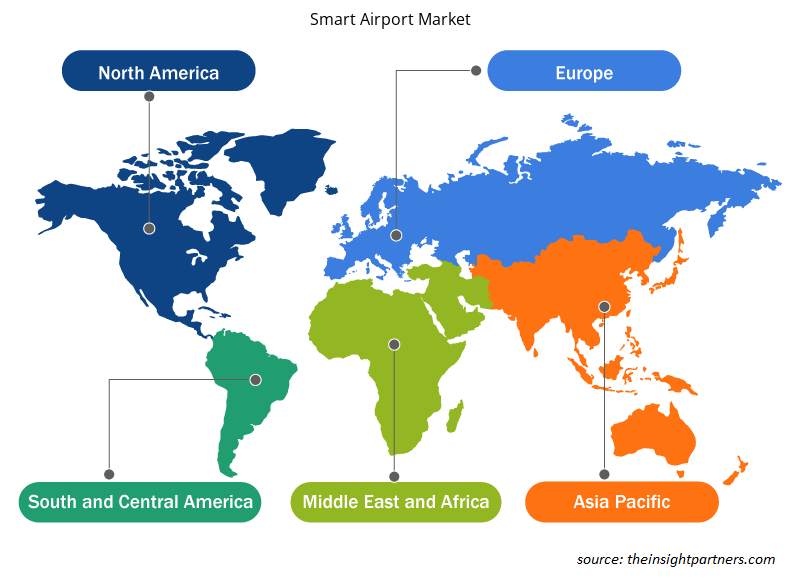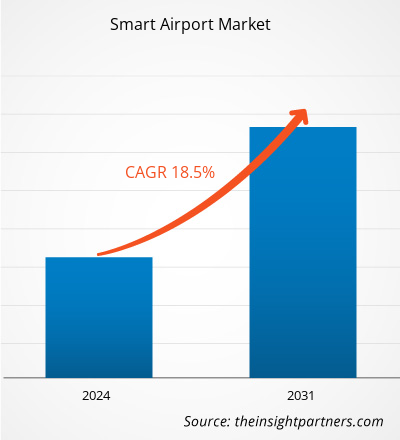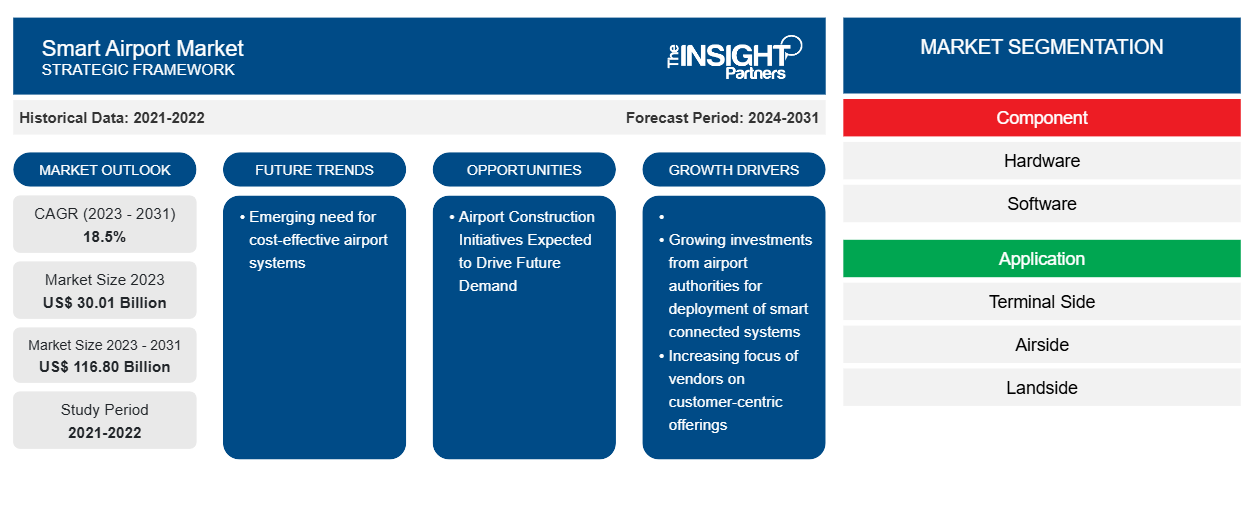Der Markt für intelligente Flughäfen soll von 30,01 Milliarden US-Dollar im Jahr 2023 auf 116,80 Milliarden US-Dollar im Jahr 2031 anwachsen. Der Markt wird zwischen 2023 und 2031 voraussichtlich eine durchschnittliche jährliche Wachstumsrate (CAGR) von 18,5 % verzeichnen. Der aufkommende Bedarf an kostengünstigen Flughafensystemen dürfte ein wichtiger Trend auf dem Markt bleiben.CAGR of 18.5% during 2023–2031. Emerging need for cost-effective airport systems is likely to remain a key trend in the market.
Marktanalyse für intelligente Flughäfen
Die Flughäfen nutzen Lösungen und Dienstleistungen von Herstellern intelligenter Flughafensysteme. Die Nachfrage nach automatisierten Systemen für intelligente Flughäfen steigt aufgrund steigender Investitionen in den Einsatz von KI- und ML-basierten Systemen an verschiedenen Flughäfen. Komponentenhersteller im Smart-Airport-Ökosystem haben kurzfristige und langfristige Verträge mit den Herstellern intelligenter Technologiegeräte wie intelligenten Datenverarbeitungssystemen , künstlicher Intelligenz-Biometrie, IoT-Sensoren, Modems, Routern und Peel-&-Stick-Sensoren abgeschlossen.Anbieter intelligenter Flughafensysteme sind Amadeus IT Group SA; Cisco System, Inc; Huawei Technologies Co., Ltd; Honeywell International Inc.; Indra Sistemas SA; SABRE GLBL Inc.; Jeppesen; Zensors und SITA. Diese Unternehmen bieten Endnutzern intelligente End-to-End-Geräte, -Dienste und -Lösungen. Zu den wichtigsten Endnutzern intelligenter Flughafensysteme zählen der Flughafen Singapur Changi, der Flughafen Seoul Incheon, die Flughäfen Houston, Tokio Haneda, der internationale Flughafen Hongkong, der internationale Flughafen Doha Hamad, der Flughafen München und die Flughäfen London Heathrow.
Marktübersicht für intelligente Flughäfen
Zu den wichtigsten Akteuren im Ökosystem des Smart-Airport-Marktes zählen Komponentenhersteller und -lieferanten, Softwareentwickler und -integratoren, Hersteller von Smart-Airport-Systemen und Endnutzer. Zu den Komponentenherstellern und -lieferanten zählen unter anderem Astronics Corporation, TE Connectivity, Molex, Panduit, Honeywell und Schneider Electric. Steigende staatliche Investitionen in den Aufbau intelligenter Flughäfen beschleunigen die Digitalisierung von Flughäfen. Sicherheit ist bei intelligenten Flughäfen von entscheidender Bedeutung. Daher arbeiten viele Smart-Airport-Behörden zusammen, um diese Einrichtungen zu sichern und ihre Betriebseffizienz zu verbessern.
Passen Sie diesen Bericht Ihren Anforderungen an
Sie erhalten kostenlos individuelle Anpassungen an jedem Bericht, einschließlich Teilen dieses Berichts oder einer Analyse auf Länderebene, eines Excel-Datenpakets sowie tolle Angebote und Rabatte für Start-ups und Universitäten.
-
Holen Sie sich die wichtigsten Markttrends aus diesem Bericht.Dieses KOSTENLOSE Beispiel umfasst eine Datenanalyse von Markttrends bis hin zu Schätzungen und Prognosen.
Treiber und Chancen des Smart Airport-Marktes
Zunehmender Fokus der Marktanbieter auf kundenorientierte Angebote
Unternehmen in der Smart-Airport-Branche konzentrieren sich auf die Bereitstellung kundenorientierter Lösungen, um die Einführung intelligenter Flughafentechnologien zu fördern. Die Nachfrage der Passagiere nach Gepäckverfolgung steigt weltweit, was einer der Hauptschwerpunkte der Flughafenbehörden ist. Laut der Zivilluftfahrtbehörde Chinas (CAAC) wollten im Jahr 2021 etwa 75 % der Fluggäste in China Details zur Gepäckverfolgung und Abholzeit ihres Gepäcks erfahren. Laut derselben Studie konzentrieren sich etwa 86 % der Fluggesellschaften in China auf die Bereitstellung von Benachrichtigungen zur Gepäckverfolgung, und 57 % der Fluggesellschaften stellen ihren Passagieren in ganz China auch Informationen zur Gepäckabholung zur Verfügung. Daher konzentrieren sich Anbieter auf dem Smart-Airport-Markt darauf, Fluggesellschaften intelligente Gepäckverwaltungssysteme bereitzustellen, um ihre Geschäftsabläufe zu automatisieren und den Passagieren ein besseres Erlebnis zu bieten. Solche Systeme sind in Cloud-basierte Airline-Anwendungen und -Datenbanken integriert, Cloud-basierte Analysen und eine Machine-to-Machine- (M2M) und IoT-Plattform integriert, um Echtzeitdaten und Ereignisse von intelligentem Gepäck zu verbinden, zu verwalten und zu sichern. Darüber hinaus trägt der Einsatz von Gepäckmanagementsystemen in Flughäfen auch dazu bei, die Gesamtbetriebskosten zu senken und die Gesamtbetriebseffizienz zu steigern.IoT platform to connect, manage, and secure real-time data and events from smart luggage. Moreover, the deployment of baggage management systems in airports also helps to reduce the overall operational costs, along with boosting overall operational efficiencies.
Neue Flughafenbauprojekte
Der Anstieg der Zahl der Flughafenbauprojekte in Schwellenländern wie China und Indien dürfte in den kommenden Jahren neue Möglichkeiten für Marktanbieter schaffen. Mehrere Regierungspläne im Zusammenhang mit dem Bau neuer Flughäfen und der Erweiterung/Modernisierung bestehender Flughäfen sind weitere wichtige Faktoren, die den Einsatz intelligenter Flughafensysteme in den kommenden Jahren unterstützen dürften. So hat die indische Regierung beispielsweise bereits 2022 angekündigt, bis Ende 2025 220 Flughäfen bauen zu wollen. Darüber hinaus kündigte die Zivilluftfahrtbehörde der Volksrepublik China (CAAC) 2018 Pläne an, bis Ende 2035 216 neue Flughäfen zu bauen, wodurch die Gesamtzahl der Flughäfen bis 2035 auf 450 steigen wird (derzeit 2023 sind es 234 Flughäfen). Solche Projekte werden in den kommenden Jahren voraussichtlich neue Möglichkeiten für Unternehmen im Bereich intelligenter Flughafentechnologie schaffen.
Segmentierungsanalyse des Smart Airport-Marktberichts
Wichtige Segmente, die zur Ableitung der Marktanalyse für intelligente Flughäfen beigetragen haben, sind Komponenten und Anwendungen.
- Basierend auf den Komponenten ist der Markt für intelligente Flughäfen in Hardware und Software unterteilt. Das Hardwaresegment ist weiter unterteilt in Sicherheitssysteme, Kommunikations- und Navigationssysteme, Endgeräte und Datenspeichersysteme. Das Hardwaresegment hatte im Jahr 2023 einen größeren Marktanteil.
- Basierend auf der Anwendung ist der Markt für intelligente Flughäfen in Terminalseite, Luftseite und Landseite unterteilt. Das Segment Terminalseite hatte im Jahr 2023 einen größeren Marktanteil.
Marktanteilsanalyse für intelligente Flughäfen nach geografischer Lage
Der geografische Umfang des Marktberichts für intelligente Flughäfen ist hauptsächlich in fünf Regionen unterteilt: Nordamerika, Europa, Asien-Pazifik, Naher Osten und Afrika sowie Südamerika.
Der asiatisch-pazifische Raum dominierte den Markt im Jahr 2023, gefolgt von Europa und Nordamerika. Darüber hinaus wird der asiatisch-pazifische Raum in den kommenden Jahren voraussichtlich die höchste durchschnittliche jährliche Wachstumsrate verzeichnen. Der Haupttreiber für den Markt für intelligente Flughäfen im asiatisch-pazifischen Raum ist die Präsenz einer großen Anzahl intelligenter Flughafenprojekte in der gesamten Region. Einige der wichtigsten intelligenten Flughäfen im asiatisch-pazifischen Raum sind beispielsweise der internationale Flughafen Hongkong, der Flughafen Shenzhen, der internationale Flughafen Peking-Daxing, der Flughafen Tokio-Haneda, der internationale Flughafen Centrair Nagoya, der internationale Flughafen Neu-Delhi, der internationale Flughafen Hyderabad, der Flughafen Seoul Incheon, der Flughafen Jeju, der Flughafen Singapur Changi, der internationale Flughafen Kuala Lumpur und der Flughafen Indonesien. Darüber hinaus werden Länder wie China und Indien bis Ende 2035 voraussichtlich mehr als 400 Flughäfen bauen, was den Markt in den kommenden Jahren weiter ankurbeln dürfte.
Regionale Einblicke in den Smart Airport-Markt
Die regionalen Trends und Faktoren, die den Smart Airport-Markt im Prognosezeitraum beeinflussen, wurden von den Analysten von Insight Partners ausführlich erläutert. In diesem Abschnitt werden auch die Marktsegmente und die Geografie des Smart Airport-Marktes in Nordamerika, Europa, im asiatisch-pazifischen Raum, im Nahen Osten und Afrika sowie in Süd- und Mittelamerika erörtert.

- Erhalten Sie regionalspezifische Daten zum Smart Airport-Markt
Umfang des Marktberichts zum intelligenten Flughafen
| Berichtsattribut | Details |
|---|---|
| Marktgröße im Jahr 2023 | 30,01 Milliarden US-Dollar |
| Marktgröße bis 2031 | 116,80 Milliarden US-Dollar |
| Globale CAGR (2023 - 2031) | 18,5 % |
| Historische Daten | 2021-2022 |
| Prognosezeitraum | 2024–2031 |
| Abgedeckte Segmente |
Nach Komponente
|
| Abgedeckte Regionen und Länder |
Nordamerika
|
| Marktführer und wichtige Unternehmensprofile |
|
Marktteilnehmerdichte: Der Einfluss auf die Geschäftsdynamik
Der Markt für intelligente Flughäfen wächst rasant. Dies wird durch die steigende Nachfrage der Endnutzer aufgrund von Faktoren wie sich entwickelnden Verbraucherpräferenzen, technologischen Fortschritten und einem größeren Bewusstsein für die Vorteile des Produkts vorangetrieben. Mit der steigenden Nachfrage erweitern Unternehmen ihr Angebot, entwickeln Innovationen, um die Bedürfnisse der Verbraucher zu erfüllen, und nutzen neue Trends, was das Marktwachstum weiter ankurbelt.
Die Marktteilnehmerdichte bezieht sich auf die Verteilung von Firmen oder Unternehmen, die in einem bestimmten Markt oder einer bestimmten Branche tätig sind. Sie gibt an, wie viele Wettbewerber (Marktteilnehmer) in einem bestimmten Marktraum im Verhältnis zu seiner Größe oder seinem gesamten Marktwert präsent sind.
Die wichtigsten auf dem Smart Airport-Markt tätigen Unternehmen sind:
- Honeywell International Inc
- Cisco Systems Inc
- Huawei Technologies Co., Ltd
- Indra Sistemas SA
- Amadeus IT Group SA
- SITA
Haftungsausschluss : Die oben aufgeführten Unternehmen sind nicht in einer bestimmten Reihenfolge aufgeführt.

- Überblick über die wichtigsten Akteure auf dem Smart Airport-Markt
Neuigkeiten und aktuelle Entwicklungen zum Smart Airport-Markt
Der Markt für intelligente Flughäfen wird durch die Erhebung qualitativer und quantitativer Daten nach Primär- und Sekundärforschung bewertet, die wichtige Unternehmenspublikationen, Verbandsdaten und Datenbanken umfasst. Nachfolgend sind einige der Entwicklungen auf dem Markt für intelligente Flughäfen aufgeführt:
Thales hat von der Flughafenmanagementgruppe SEA (Società per azioni Esercizi Aeroportuali) den Auftrag erhalten, eine innovative digitale Plattformlösung zu liefern, die die Gruppe bei der Steigerung der Betriebseffizienz unterstützen soll. (Quelle: Thales, Pressemitteilung, März 2022)
- Während der ersten Airports Innovate Exhibition, die vom 20. bis 22. November in Maskat, Oman, stattfindet, stellte Huawei eine Reihe brandneuer intelligenter Flughafenlösungen für internationale Märkte vor, darunter die Fully Connected Fiber Network Solution und die Smart Airport Perimeter Security mit Fiber Sensing Solution. (Quelle: Huawei, Pressemitteilung, November 2023)
Abdeckung und Ergebnisse des Smart Airport-Marktberichts
Der Bericht „Smart Airport-Marktgröße und -prognose (2021–2031)“ bietet eine detaillierte Analyse des Marktes, die die folgenden Bereiche abdeckt:
- Marktgröße und Prognose für intelligente Flughäfen auf globaler, regionaler und Länderebene für alle wichtigen Marktsegmente, die im Rahmen des Berichts abgedeckt sind
- Markttrends und Marktdynamiken für intelligente Flughäfen wie Treiber, Einschränkungen und wichtige Chancen
- Detaillierte Porter-Fünf-Kräfte-Analyse
- Analyse des Smart-Airport-Marktes mit wichtigen Markttrends, globalen und regionalen Rahmenbedingungen, wichtigen Akteuren, Vorschriften und aktuellen Marktentwicklungen
- Branchenlandschaft und Wettbewerbsanalyse, einschließlich Marktkonzentration, Heatmap-Analyse, prominenten Akteuren und aktuellen Entwicklungen für den Smart-Airport-Markt
- Detaillierte Firmenprofile
- Historische Analyse (2 Jahre), Basisjahr, Prognose (7 Jahre) mit CAGR
- PEST- und SWOT-Analyse
- Marktgröße Wert/Volumen – Global, Regional, Land
- Branchen- und Wettbewerbslandschaft
- Excel-Datensatz
Aktuelle Berichte
Erfahrungsberichte
Grund zum Kauf
- Fundierte Entscheidungsfindung
- Marktdynamik verstehen
- Wettbewerbsanalyse
- Kundeneinblicke
- Marktprognosen
- Risikominimierung
- Strategische Planung
- Investitionsbegründung
- Identifizierung neuer Märkte
- Verbesserung von Marketingstrategien
- Steigerung der Betriebseffizienz
- Anpassung an regulatorische Trends























 Kostenlose Probe anfordern für - Smart Airport Market
Kostenlose Probe anfordern für - Smart Airport Market